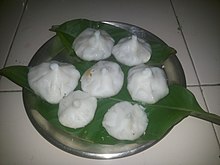Modak
This article needs additional citations for verification. (December 2013) |
 | |
| Type | Dumpling |
|---|---|
| Course | Dessert |
| Place of origin | India |
| Main ingredients | Rice flour, or wheat and maida flour, coconut, jaggery |
A modak(Marathi: मोदक) is a sweet dumpling popular in Western, eastern and Southern India. It is called modak (मोदक) in Marathi, (ମୋଦକ) Oriya and Konkani as well as Gujarati language, Kozhakkatta in Malayalam, modhaka or kadubu in Kannada, modhakam or kozhakkattai in Tamil, and kudumu in Telugu.


The sweet filling inside a modak is made up of fresh grated coconut and jaggery, while the soft shell is made from rice flour, or wheat flour mixed with khava or maida flour. The dumpling can be fried or steamed. The steamed version, called ukdiche modak, is eaten hot with ghee.
Modaks have a special importance in the worship of the Hindu god Ganesh; modak is believed to be his favorite food, which begets him the moniker modakapriya (the one who likes modak) in Sanskrit. During the Ganesh worship ceremony, known in India as Ganesha Chaturthi the puja always concludes with an offering of twenty-one modaks to the deity and as prasad. Modaks made with rice flour shell are preferred for this purpose, however, wheat shell version are also used. Innovative recipes for modaks have also been created. These include banana nachni modak, motichoor modak[1] and chocolate modak.
Gallery
-
Modak offered in a Ganesh Puja
-
Modak close up
-
inner side with vertical cut
-
inner side with vertical cut
See also
References
- ^ Innovative yet delicious modak recipes http://www.dnaindia.com/lifestyle/1884683/report-innovative-yet-delicious-modak-recipes







